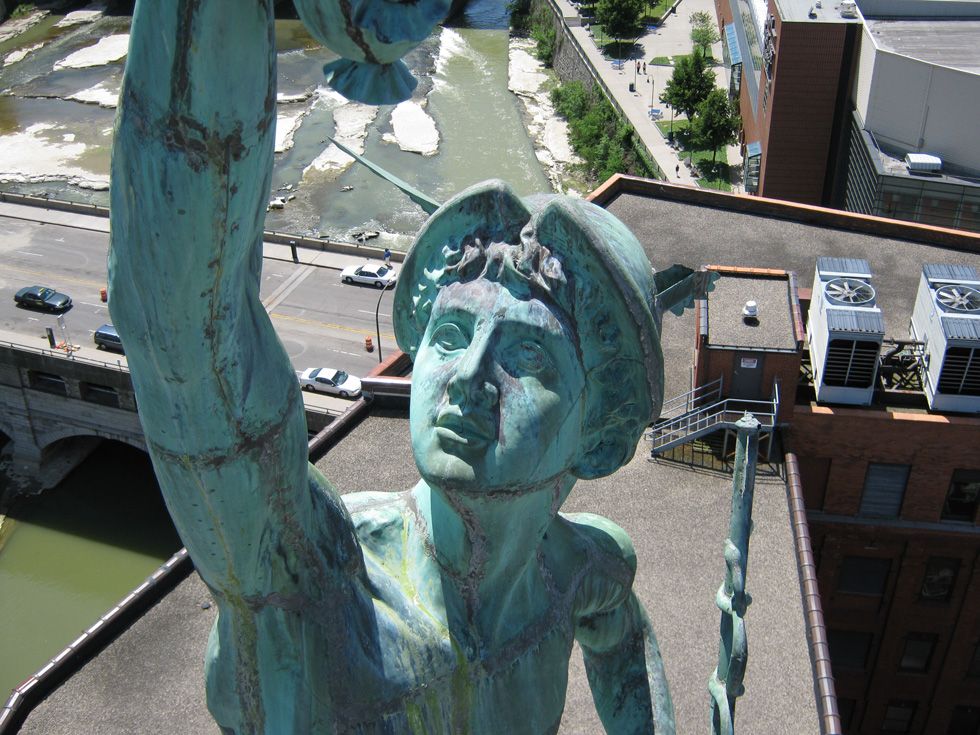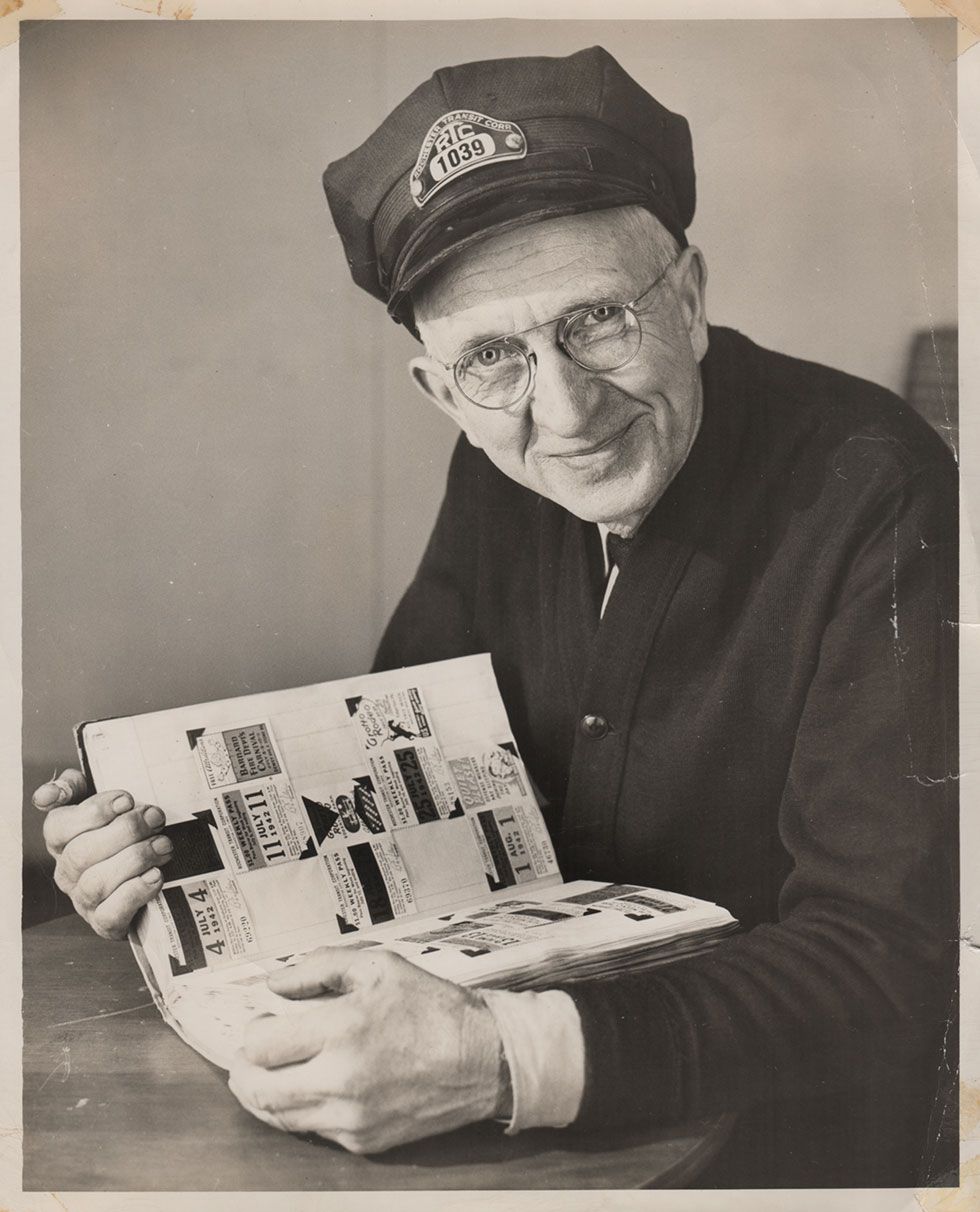This article was scraped from Rochester Subway. This is a blog about Rochester history and urbanism has not been published since 2017. The current owners are now publishing link spam which made me want to preserve this history.. The original article was published May 29, 2014 and can be found here.
![Statue of Mercury. Rochester, NY. [PHOTO: Wes Plant]](https://senseofplace.dev/content/images/photos/rochester-mercury-statue-renovation-2011-40.jpg)
On Facebook last week I shared an old photo of Rochester's iconic Mercury statue

as it was being removed from its original perch atop the Kimball Tobacco Factory in 1951. The factory was demolished to make way for the War Memorial and the statue sat in storage until the Lawyers Cooperative (Aqueduct Building) became his new home in 1973.
Fast forward to June 2011; the 21 foot tall, 700 pound statue gets a thorough inspection for signs of wear and a good restoration. The following photos were taken by Wes Plant during that checkup. And they show Mercury in detail you've probably never seen before...
![Statue of Mercury. Rochester, NY. [PHOTO: Wes Plant]](https://senseofplace.dev/content/images/photos/rochester-mercury-statue-renovation-2011-05.jpg)
Looking up toward Mercury, inspectors are hoisted up in a bucket to get a good look at the Rochester landmark.
![Statue of Mercury. Rochester, NY. [PHOTO: Wes Plant]](https://senseofplace.dev/content/images/photos/rochester-mercury-statue-renovation-2011-11.jpg)
In 1881, young sculpture Guernsey Mitchell was commissioned by his brother-in-law, William Kimball, to create a decoration for his new tobacco factory's smokestack. The Kimball Tobacco Factory was located at the corner of Court Street and Exchange Street.
![Statue of Mercury. Rochester, NY. [PHOTO: Wes Plant]](https://senseofplace.dev/content/images/photos/rochester-mercury-statue-renovation-2011-39.jpg)
At the time, it was described as the largest copperplated statue in America. Mercury quickly became the hallmark of Rochester's Skyline.
![Statue of Mercury. Rochester, NY. [PHOTO: Wes Plant]](https://senseofplace.dev/content/images/photos/rochester-mercury-statue-renovation-2011-28.jpg)
Cluett-Peabody & Company acquired Kimball's building in 1905 for the production of its linen shirt collars. By the 1930s, the City had acquired the property, with the help of George Eastman. The factory building was used for several City functions, including as the central branch of the public library, until it was demo'd in 1951 to become part of Rochester's new civic center. The statue was moved to a warehouse in Charlotte.
![Statue of Mercury. Rochester, NY. [PHOTO: Wes Plant]](https://senseofplace.dev/content/images/photos/rochester-mercury-statue-renovation-2011-74.jpg)
In 1973 our old friend was re-introduced to the skyline - this time atop the Aqueduct Building, one block north of its original home.
![Statue of Mercury. Rochester, NY. [PHOTO: Wes Plant]](https://senseofplace.dev/content/images/photos/rochester-mercury-statue-renovation-2011-75.jpg)
Mercury was the Roman version of Hermes, the Greek god of messages, eloquence and of trade, particularly of the grain trade (fitting for the Flour City).
![Statue of Mercury. Rochester, NY. [PHOTO: Wes Plant]](https://senseofplace.dev/content/images/photos/rochester-mercury-statue-renovation-2011-77.jpg)
He was usually depicted wearing winged shoes, a winged hat, and carrying the caduceus, a herald's staff with two entwined snakes. In Greek mythology, the staff was a gift from Apollo.
The pose chosen by Mitchell--poised on one foot, one arm pointed toward the heavens--was borrowed from the work of Giambologna

.
![Statue of Mercury. Rochester, NY. [PHOTO: Wes Plant]](https://senseofplace.dev/content/images/photos/rochester-mercury-statue-renovation-2011-36.jpg)
Mercury was also considered a god of abundance and commercial success. To emphasize this characteristic, and to reflect the success of his brother-in-law's business, Mitchell added a bag of gold to Mercury's right hand.
![Statue of Mercury. Rochester, NY. [PHOTO: Wes Plant]](https://senseofplace.dev/content/images/photos/rochester-mercury-statue-renovation-2011-29.jpg)
Here's something you wouldn't notice while standing on the ground... from this vantage point we can clearly see that Mercury is supported by a zephyr. In Greek mythology, Zephyr was the gentle wind of the west and the interceder between the world of the living and the underworld. Zephyr also brought the spring rains that were so valuable for awakening the nature.
![Statue of Mercury. Rochester, NY. [PHOTO: Wes Plant]](https://senseofplace.dev/content/images/photos/rochester-mercury-statue-renovation-2011-13.jpg)
Alright sir, time for your checkup...
![Statue of Mercury. Rochester, NY. [PHOTO: Wes Plant]](https://senseofplace.dev/content/images/photos/rochester-mercury-statue-renovation-2011-17.jpg)
Let's have a peek under your wings.
![Statue of Mercury. Rochester, NY. [PHOTO: Wes Plant]](https://senseofplace.dev/content/images/photos/rochester-mercury-statue-renovation-2011-63.jpg)
![Statue of Mercury. Rochester, NY. [PHOTO: Wes Plant]](https://senseofplace.dev/content/images/photos/rochester-mercury-statue-renovation-2011-64.jpg)
![Statue of Mercury. Rochester, NY. [PHOTO: Wes Plant]](https://senseofplace.dev/content/images/photos/rochester-mercury-statue-renovation-2011-71.jpg)
![Statue of Mercury. Rochester, NY. [PHOTO: Wes Plant]](https://senseofplace.dev/content/images/photos/rochester-mercury-statue-renovation-2011-23.jpg)
Now turn your head and cough for me.
![Statue of Mercury. Rochester, NY. [PHOTO: Wes Plant]](https://senseofplace.dev/content/images/photos/rochester-mercury-statue-renovation-2011-20.jpg)
![Statue of Mercury. Rochester, NY. [PHOTO: Wes Plant]](https://senseofplace.dev/content/images/photos/rochester-mercury-statue-renovation-2011-22.jpg)
What happens if I give this a tug?
![Statue of Mercury. Rochester, NY. [PHOTO: Wes Plant]](https://senseofplace.dev/content/images/photos/rochester-mercury-statue-renovation-2011-24.jpg)
Hmm... that's going to need a prescription.
![Statue of Mercury. Rochester, NY. [PHOTO: Wes Plant]](https://senseofplace.dev/content/images/photos/rochester-mercury-statue-renovation-2011-41.jpg)
Here's a closeup of that bag of gold.
![Statue of Mercury. Rochester, NY. [PHOTO: Wes Plant]](https://senseofplace.dev/content/images/photos/rochester-mercury-statue-renovation-2011-44.jpg)
![Statue of Mercury. Rochester, NY. [PHOTO: Wes Plant]](https://senseofplace.dev/content/images/photos/rochester-mercury-statue-renovation-2011-45.jpg)
Looks like a little fungal thing happening here.
![Statue of Mercury. Rochester, NY. [PHOTO: Wes Plant]](https://senseofplace.dev/content/images/photos/rochester-mercury-statue-renovation-2011-49.jpg)
![Statue of Mercury. Rochester, NY. [PHOTO: Wes Plant]](https://senseofplace.dev/content/images/photos/rochester-mercury-statue-renovation-2011-43.jpg)
*** giggle ***
![Statue of Mercury. Rochester, NY. [PHOTO: Wes Plant]](https://senseofplace.dev/content/images/photos/rochester-mercury-statue-renovation-2011-58.jpg)
![Statue of Mercury. Rochester, NY. [PHOTO: Wes Plant]](https://senseofplace.dev/content/images/photos/rochester-mercury-statue-renovation-2011-34.jpg)
Can you wiggle your toes?
![Statue of Mercury. Rochester, NY. [PHOTO: Wes Plant]](https://senseofplace.dev/content/images/photos/rochester-mercury-statue-renovation-2011-59.jpg)
Perrrfect, thanks.
![Statue of Mercury. Rochester, NY. [PHOTO: Wes Plant]](https://senseofplace.dev/content/images/photos/rochester-mercury-statue-renovation-2011-46.jpg)
![Statue of Mercury. Rochester, NY. [PHOTO: Wes Plant]](https://senseofplace.dev/content/images/photos/rochester-mercury-statue-renovation-2011-42.jpg)
![Statue of Mercury. Rochester, NY. [PHOTO: Wes Plant]](https://senseofplace.dev/content/images/photos/rochester-mercury-statue-renovation-2011-31.jpg)
![Statue of Mercury. Rochester, NY. [PHOTO: Wes Plant]](https://senseofplace.dev/content/images/photos/rochester-mercury-statue-renovation-2011-32.jpg)
![Statue of Mercury. Rochester, NY. [PHOTO: Wes Plant]](https://senseofplace.dev/content/images/photos/rochester-mercury-statue-renovation-2011-53.jpg)
![Statue of Mercury. Rochester, NY. [PHOTO: Wes Plant]](https://senseofplace.dev/content/images/photos/rochester-mercury-statue-renovation-2011-56.jpg)
![Statue of Mercury. Rochester, NY. [PHOTO: Wes Plant]](https://senseofplace.dev/content/images/photos/rochester-mercury-statue-renovation-2011-57.jpg)
![Statue of Mercury. Rochester, NY. [PHOTO: Wes Plant]](https://senseofplace.dev/content/images/photos/rochester-mercury-statue-renovation-2011-62.jpg)
![Statue of Mercury. Rochester, NY. [PHOTO: Wes Plant]](https://senseofplace.dev/content/images/photos/rochester-mercury-statue-renovation-2011-65.jpg)
![Statue of Mercury. Rochester, NY. [PHOTO: Wes Plant]](https://senseofplace.dev/content/images/photos/rochester-mercury-statue-renovation-2011-68.jpg)
![Statue of Mercury. Rochester, NY. [PHOTO: Wes Plant]](https://senseofplace.dev/content/images/photos/rochester-mercury-statue-renovation-2011-72.jpg)
![Statue of Mercury. Rochester, NY. [PHOTO: Wes Plant]](https://senseofplace.dev/content/images/photos/rochester-mercury-statue-renovation-2011-78.jpg)
![Statue of Mercury. Rochester, NY. [PHOTO: Wes Plant]](https://senseofplace.dev/content/images/photos/rochester-mercury-statue-renovation-2011-79.jpg)
Looking good, big guy. Eat right, get regular exercise, and you should be good for another 130 years.
Thanks to Mark O'Brien for sending these photos!


